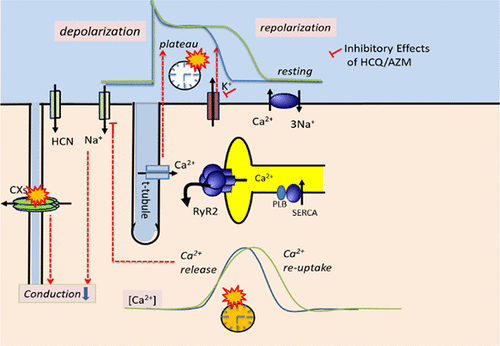当前位置:
X-MOL 学术
›
ACS Pharmacol. Transl. Sci.
›
论文详情
Our official English website, www.x-mol.net, welcomes your
feedback! (Note: you will need to create a separate account there.)
Electrophysiological and Proarrhythmic Effects of Hydroxychloroquine Challenge in Guinea-Pig Hearts
ACS Pharmacology & Translational Science ( IF 4.9 ) Pub Date : 2021-08-30 , DOI: 10.1021/acsptsci.1c00166 Gongxin Wang 1 , Chieh-Ju Lu 1 , Andrew W Trafford 2 , Xiaohui Tian 3 , Hannali M Flores 4 , Piotr Maj 5 , Kevin Zhang 6 , Yanhong Niu 7 , Luxi Wang 1 , Yimei Du 8 , Xinying Ji 3 , Yanfang Xu 9 , Lin Wu 10 , Dan Li 11 , Neil Herring 11 , David Paterson 11 , Christopher L-H Huang 12, 13 , Henggui Zhang 4, 13, 14 , Ming Lei 5, 13 , Guoliang Hao 1, 11
ACS Pharmacology & Translational Science ( IF 4.9 ) Pub Date : 2021-08-30 , DOI: 10.1021/acsptsci.1c00166 Gongxin Wang 1 , Chieh-Ju Lu 1 , Andrew W Trafford 2 , Xiaohui Tian 3 , Hannali M Flores 4 , Piotr Maj 5 , Kevin Zhang 6 , Yanhong Niu 7 , Luxi Wang 1 , Yimei Du 8 , Xinying Ji 3 , Yanfang Xu 9 , Lin Wu 10 , Dan Li 11 , Neil Herring 11 , David Paterson 11 , Christopher L-H Huang 12, 13 , Henggui Zhang 4, 13, 14 , Ming Lei 5, 13 , Guoliang Hao 1, 11
Affiliation

|
Hydroxychloroquine (HCQ), clinically established in antimalarial and autoimmune therapy, recently raised cardiac arrhythmogenic concerns when used alone or with azithromycin (HCQ+AZM) in Covid-19. We report complementary, experimental, studies of its electrophysiological effects. In patch clamped HEK293 cells expressing human cardiac ion channels, HCQ inhibited IKr and IK1 at a therapeutic concentrations (IC50s: 10 ± 0.6 and 34 ± 5.0 μM). INa and ICaL showed higher IC50s; Ito and IKs were unaffected. AZM slightly inhibited INa, ICaL, IKs, and IKr, sparing IK1 and Ito. (HCQ+AZM) inhibited IKr and IK1 (IC50s: 7.7 ± 0.8 and 30.4 ± 3.0 μM), sparing INa, ICaL, and Ito. Molecular induced-fit docking modeling confirmed potential HCQ-hERG but weak AZM-hERG binding. Effects of μM-HCQ were studied in isolated perfused guinea-pig hearts by multielectrode, optical RH237 voltage, and Rhod-2 mapping. These revealed reversibly reduced left atrial and ventricular action potential (AP) conduction velocities increasing their heterogeneities, increased AP durations (APDs), and increased durations and dispersions of intracellular [Ca2+] transients, respectively. Hearts also became bradycardic with increased electrocardiographic PR and QRS durations. The (HCQ+AZM) combination accentuated these effects. Contrastingly, (HCQ+AZM) and not HCQ alone disrupted AP propagation, inducing alternans and torsadogenic-like episodes on voltage mapping during forced pacing. O’Hara-Rudy modeling showed that the observed IKr and IK1 effects explained the APD alterations and the consequently prolonged Ca2+ transients. The latter might then downregulate INa, reducing AP conduction velocity through recently reported INa downregulation by cytosolic [Ca2+] in a novel scheme for drug action. The findings may thus prompt future investigations of HCQ’s cardiac safety under particular, chronic and acute, clinical situations.
中文翻译:

羟氯喹挑战对豚鼠心脏的电生理和致心律失常作用
羟氯喹 (HCQ) 已在临床上用于抗疟疾和自身免疫治疗,但最近在 Covid-19 中单独使用或与阿奇霉素 (HCQ+AZM) 一起使用时,引起了心律失常的担忧。我们报告了对其电生理效应的补充性实验研究。在表达人心脏离子通道的膜片钳 HEK293 细胞中,HCQ以治疗浓度抑制 I Kr和 I K1 (IC 50 s:10 ± 0.6 和 34 ± 5.0 μM)。I Na和 I CaL显示出更高的 IC 50 s;I to和 I Ks不受影响。AZM 轻微抑制 I Na、I CaL、 I Ks和 I Kr,但不影响 I K1和 I to。(HCQ+AZM) 抑制 I Kr和 I K1 (IC 50 s: 7.7 ± 0.8 和 30.4 ± 3.0 μM),保留 I Na、 I CaL和 I to。分子诱导拟合对接模型证实了 HCQ-hERG 的潜在结合,但 AZM-hERG 的结合较弱。通过多电极、光学 RH237 电压和 Rhod-2 绘图研究了 μM-HCQ 对离体灌注豚鼠心脏的影响。这些结果分别揭示了左心房和心室动作电位 (AP) 传导速度可逆性降低,增加了它们的异质性、AP 持续时间 (APD) 增加以及细胞内 [Ca 2+ ] 瞬变的持续时间和离散度增加。随着心电图 PR 和 QRS 持续时间的增加,心脏也变得心动过缓。(HCQ+AZM) 组合增强了这些效果。相比之下,(HCQ+AZM)而不是单独的HCQ会扰乱AP传播,在强制起搏期间在电压映射上诱导交替和类似扭转的发作。O'Hara-Rudy 模型表明,观察到的 I Kr和 I K1效应解释了 APD 变化以及因此延长的 Ca 2+瞬变。后者可能会下调 I Na,通过最近报道的一种新的药物作用方案中胞质 [Ca 2+ ] 下调 I Na来降低 AP 传导速度。因此,这些发现可能会促使未来在特定的慢性和急性临床情况下对 HCQ 的心脏安全性进行研究。
更新日期:2021-10-08
中文翻译:

羟氯喹挑战对豚鼠心脏的电生理和致心律失常作用
羟氯喹 (HCQ) 已在临床上用于抗疟疾和自身免疫治疗,但最近在 Covid-19 中单独使用或与阿奇霉素 (HCQ+AZM) 一起使用时,引起了心律失常的担忧。我们报告了对其电生理效应的补充性实验研究。在表达人心脏离子通道的膜片钳 HEK293 细胞中,HCQ以治疗浓度抑制 I Kr和 I K1 (IC 50 s:10 ± 0.6 和 34 ± 5.0 μM)。I Na和 I CaL显示出更高的 IC 50 s;I to和 I Ks不受影响。AZM 轻微抑制 I Na、I CaL、 I Ks和 I Kr,但不影响 I K1和 I to。(HCQ+AZM) 抑制 I Kr和 I K1 (IC 50 s: 7.7 ± 0.8 和 30.4 ± 3.0 μM),保留 I Na、 I CaL和 I to。分子诱导拟合对接模型证实了 HCQ-hERG 的潜在结合,但 AZM-hERG 的结合较弱。通过多电极、光学 RH237 电压和 Rhod-2 绘图研究了 μM-HCQ 对离体灌注豚鼠心脏的影响。这些结果分别揭示了左心房和心室动作电位 (AP) 传导速度可逆性降低,增加了它们的异质性、AP 持续时间 (APD) 增加以及细胞内 [Ca 2+ ] 瞬变的持续时间和离散度增加。随着心电图 PR 和 QRS 持续时间的增加,心脏也变得心动过缓。(HCQ+AZM) 组合增强了这些效果。相比之下,(HCQ+AZM)而不是单独的HCQ会扰乱AP传播,在强制起搏期间在电压映射上诱导交替和类似扭转的发作。O'Hara-Rudy 模型表明,观察到的 I Kr和 I K1效应解释了 APD 变化以及因此延长的 Ca 2+瞬变。后者可能会下调 I Na,通过最近报道的一种新的药物作用方案中胞质 [Ca 2+ ] 下调 I Na来降低 AP 传导速度。因此,这些发现可能会促使未来在特定的慢性和急性临床情况下对 HCQ 的心脏安全性进行研究。











































 京公网安备 11010802027423号
京公网安备 11010802027423号